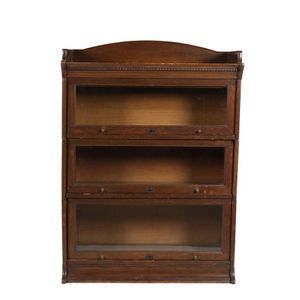Art Deco Birch Cabinet
You must be a subscriber, and be logged in to view price and dealer details.
Subscribe Now to view actual auction price for this item
When you subscribe, you have the option of setting the currency in which to display prices to $Au, $US, $NZ or Stg.
- Circa - A Latin term meaning 'about', often used in the antique trade to give an approximate date for the piece, usually considered to be five years on either side of the circa year. Thus, circa 1900 means the piece was made about 1900, probably between 1895 and 1905. The expression is sometimes abbreviated to c.1900.
- Birch - Birch is a Northern Hemisphere hardwood, closely related to the beech/oak family, and was a timber popular with 18th century craftsmen. Because of the blonde-golden colour of the grain when polished and its close grain, as a veneer it is often used as a substitute for satinwood where cost savings are required. From the late 18th century cabinetmakers in Russia and Eastern Europe used it in the solid for chairs and other furniture.
Karelian birch is birch with a burr grain that resembles marble, from the Karelia region between Finland and Russia. Because only 30% to 40% of seeds result in trees with Karelian birch features, and the fact that it is very slow growing, the timber is very expensive. - Apron - A decorative wooden panel that sits underneath the top surface of a table or chair, and unites the top of the piece with the legs, running at right angles to the underside. On carcase furniture such as a chest or wardrobe, the apron sits below the drawers or doors and attaches to the legs.
On carcase furniture without legs the panel under the drawers or doors sits on the floor and is termed a plinth.
An apron can provide a decorative touch to an otherwise unadorned piece of furniture and at the same time provide structural support and strength. They can be carved or pierced and quite elaborate. - Art Deco Period - The Art Deco period was a cultural movement that emerged in the 1920s and 1930s, and was characterized by its emphasis on modernism, luxury, and elegance. The name "Art Deco" comes from the Exposition Internationale des Arts Décoratifs et Industriels Modernes, a large exhibition held in Paris in 1925 that showcased the latest trends in decorative arts.
Art Deco was a reaction against the ornate and elaborate styles of the previous era, and reflected a new modern sensibility. It was characterized by streamlined, geometric shapes, bright colours, and the use of new materials such as chrome, glass, and Bakelite. Art Deco designers sought to create a sense of luxury and sophistication, often incorporating expensive materials such as ivory, marble, and rare woods.
Art Deco had a significant impact on a wide range of artistic fields, including architecture, fashion, graphic design, and interior design. Some of the most iconic examples of Art Deco architecture include the Empire State Building in New York City, the Hoover Building in London, and the Palais de Chaillot in Paris.
The Art Deco period came to an end in the 1940s, as World War II and changing cultural trends led to a shift in artistic styles. However, Art Deco remains an important influence on design and art, and continues to be celebrated for its modernist sensibility and glamorous aesthetic. - Reeding - A series of parallel, raised convex mouldings or bands, in section resembling a series of the letter 'm'. The opposite form of fluting, with which it is sometimes combined. Reeding is commonly found on chair legs, either turned or straight, on the arms and backs of chairs and couches and around table edges in the Neoclassical or Classical Revival manner. Reeding was also used as a form of decoration during the Edwardian period, but it is usually much shallower and evidently machine made.
This item has been included into following indexes:
-
bookcases, function or type
- four door and library, other timbers 128
- open fronted 160
- pairs 194
- bookcases, period - Art Deco 13
Visually similar items

Modular bookcase, by G Smerdon and Sons, early 20th century oak, three part, Globe Wernicke style, height 123 cm, length 89 cm, depth 36 cm

George II walnut and oak flat front chest with two short and three long graduated crossbanded drawers on bracket feet

A French walnut four drawer black marble top chest. 80 cm high, 80 cm wide, 46 cm deep.

A N.Z. colonial kauri scotch chest, four small drawers and one hat box drawer over three full width, mottled kauri drawer fronts, ornate metal handles with matching escutcheon plates, raised on plinth base. 106 cm x 55 cm x 123 cm
